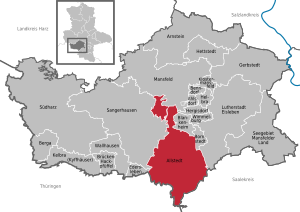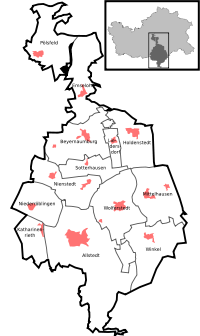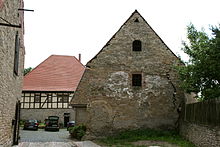Allstedt
| coat of arms | Germany map | |
|---|---|---|

|
Coordinates: 51 ° 24 ' N , 11 ° 23' E |
|
| Basic data | ||
| State : | Saxony-Anhalt | |
| County : | Mansfeld-Südharz | |
| Height : | 140 m above sea level NHN | |
| Area : | 149.81 km 2 | |
| Residents: | 7685 (Dec. 31, 2019) | |
| Population density : | 51 inhabitants per km 2 | |
| Postal code : | 06542 | |
| Primaries : | 03464, 034652, 034659 | |
| License plate : | MSH, EIL, HET, ML, SGH | |
| Community key : | 15 0 87 015 | |
| LOCODE : | DE 2AB | |
City administration address : |
Forststrasse 9 06542 Allstedt |
|
| Website : | ||
| Mayor : | Jürgen Richter ( CDU ) | |
| Location of the city of Allstedt in the district of Mansfeld-Südharz | ||
Allstedt ( ) is a town in the district of Mansfeld-Südharz in southwest Saxony-Anhalt .
location
The city is only a few kilometers from the Thuringian border. Two rivers run in the city corridor, the smaller Rohne , which comes from the Hornburger Sattel in the northeast, and the larger Helme , which comes from the west, turns south at Katharinenrieth to the confluence with the Unstrut . The helmets and the Unstrut form a fertile plain here ( the reed in the Goldene Aue ). The foothills of the southern Harz begin north of Allstedt , and the striking Kyffhäuser Mountains can be seen in the west . In the south, after crossing the wide Unstrut valley, lies the ridge of the Hohe Schrecke and in the east, after a hilly landscape behind Querfurt, the terrain gradually slopes down towards the Saale . The Saale-Unstrut-Triasland nature park is located southeast of Allstedt .
The neighboring communities of Allstedt are Mansfeld in the north, Blankenheim and Lutherstadt Eisleben in the east, Querfurt ( Saalekreis ), Roßleben-Wiehe , Artern and Mönchpfiffel-Nikolausrieth (the last three in the Kyffhäuserkreis ) in the south, and Edersleben and Sangerhausen in the west.
City structure
Allstedt is divided into a core town and 12 localities, the successors of the incorporated communities. These are listed in the following table:
| Locality | Residents | Districts |
The towns of Allstedt (clickable map) |
|---|---|---|---|
| Allstedt | 2959 | Allstedt and Klosternaundorf | |
| Beyernaumburg | 804 | Beyernaumburg (763) and Othal (41) | |
| Emseloh | 557 | Emseloh | |
| Holdenstedt | 666 | Holdenstedt | |
| Katharinenrieth | 211 | Katharinenrieth | |
| Liedersdorf | 273 | Liedersdorf | |
| Mittelhausen | 541 | Einsdorf (158) and Mittelhausen (383) | |
| Niederröblingen | 427 | Niederröblingen | |
| Nienstedt | 363 | Einsingen (162) and Nienstedt (201) | |
| Pölsfeld | 383 | Pölsfeld | |
| Sotterhausen | 241 | Sotterhausen | |
| angle | 316 | angle | |
| Wolferstedt | 686 | Wolferstedt |
The population figures refer to July 30, 2013.
climate
The annual precipitation is 488 mm. The rainfall is extremely low. They are in the lower twentieth of the values recorded in Germany. Lower values are registered at only 2% of the German Weather Service's measuring stations . The driest month is February, with the most rainfall in June. In June there is 2.1 times more rainfall than in February. The rainfall varies moderately. Lower seasonal fluctuations are recorded at 51% of the measuring stations .
history
As an old Thuringian village, Allstedt already had in the 5th / 6th Century exists. In a register of the tithe of the Hersfeld monastery , which was created between 881 and 899, Allstedt is named as the place of the tithe of Altstedi im Friesenfeld . Heinrich I signed a document in Allstedt in 935, Allstedt became a royal court and later an imperial palace .
The extinct ministerial family "von Allstedt" had their headquarters here from the 12th to the middle of the 14th century. Around 1200 the Wigberti Church was rebuilt as a stone building. Allstedt received city rights in 1425 , and from 1516 onwards the city had a seal. Thomas Müntzer became pastor at St. John's Church in 1523 . He preached in German. On July 13, 1524, he gave the “ Prince Sermon ” in the palace chapel in front of Duke Johann and Elector Friedrich . A new school was mentioned in 1568 and viticulture yields have been documented since 1570.
In the Thirty Years' War live Wallenstein , Tilly and Gustavus Adolphus soldiers in Allstedt. The plague afflicts Allstedt in 1681: 817 people died in the city between May and December. The new St. John's Church was consecrated in 1765.
Between 1776 and 1802, Johann Wolfgang von Goethe often stayed in Allstedt on state business. At the castle he wrote, among other things, some acts of his " Iphigenie ". The first Allstedter Wochenblatt appeared in 1840. A sugar factory was built in 1851, a malt factory in 1885 and a metal works in 1890. In 1894 it was connected to the railway network (Oberröblingen - Allstedt route), and in 1899 Allstedt got street lighting with gas lamps .
In the First World War 114 Allstedt died as soldiers. In 1920 Allstedt, formerly part of the Grand Duchy of Saxony-Weimar-Eisenach , came with the Weimar district as an exclave to the Free State of Thuringia . In 1922 Allstedt was connected to the power grid.
On April 11, 1945, Allstedt was bombed by US planes. 11 people were killed and there was major damage to buildings.
Then the Americans moved into Allstedt. The painter Robert Deterra had taken care of the hoisting of white flags, for which he was sentenced to death by the mayor and NSDAP local group leader Conrad Kirst. In the turmoil of the occupation he was able to escape and save his life.
In July the Soviet Army took over their zone of occupation. There was the denazification began the dismantling of the plants. Resettled and displaced persons from the eastern regions came to Allstedt, which was assigned to the province of Saxony with effect from October 1, 1945 .
Land reform began in 1946. Allstedt was flooded in 1947. In 1952 the construction of the Soviet Army airfield began. The collectivization in agriculture took place in 1960. In 1973 the Reichsbahn stopped passenger traffic between Oberröblingen and Allstedt. The castle was renovated in 1974 and a museum was set up.
On January 1, 2010, the previously independent communities of Beyernaumburg , Emseloh , Holdenstedt , Katharinenrieth , Liedersdorf , Mittelhausen , Niederröblingen (Helme) , Nienstedt , Pölsfeld , Sotterhausen and Wolferstedt were incorporated into the new town of Allstedt from the Allstedt-Kaltenborn administrative community . On September 1, 2010, Winkel followed by law .
politics
City council
The city council is elected for five years and consists of 20 members and the mayor (Jürgen Richter, CDU ).
Since the local elections on May 25, 2014, the seats have been distributed among the individual parties and lists as follows:
| Party / list | Seats |
| CDU | 6th |
| left | 3 |
| SPD | 3 |
| FDP | 2 |
| Free voters Allstedt | 4th |
| Individual applicants | 2 |
Like the SPD and Free Voters, the CDU and FDP have each formed a parliamentary group.
badges and flags
The coat of arms was approved by the Halle administrative district on November 9, 1998 and registered under No. 55/1998 in the Saxony-Anhalt State Archives .
Blazon : “Split and half-split; in front in red a crowned silver eagle at the slit, behind black over silver, covered with two diagonally crossed red swords. "
The flag of the city shows - derived from the main colors of the coat of arms - the colors white and red.
Town twinning
Allstedt maintains partnerships with Vrbove in Slovakia and Vítkov in the Czech Republic.
Economy and Infrastructure
Dutch investors planned a large pig fattening facility near Allstedt. A citizens' initiative was able to prevent this project in 2010. For this purpose, a 2.5 km long solar park is to be built along the runway of the airfield .
Allstedt is on the A 38 Göttingen - Leipzig (exit Allstedt). Allstedt station on the railway line from Oberröblingen has not been used for passenger traffic since 1973 and the connection was dismantled in 1999. The next train stations are now in Sangerhausen and Artern on the Sangerhausen – Erfurt railway line . There are bus connections to these places several times a day.
Allstedt has a small airfield that was used by the Red Army until 1992 .
Culture and sights
- Pfalz Allstedt . Allstedt Castle emerged from the Palatinate. It is often referred to as the castle and today houses a museum about the history of Allstedt and the castle as well as a castle café and a beer garden in the outer bailey. Events (including Castle Spring, Allstedter Christmas, #adventimturm) take place regularly in the castle and palace complex. At the same time, the castle is also the seat of the Association of German Gunpowder Gunner (VDSK),
- Wigberti Church from the 8th century
- In the district of Holdenstedt, the association Feuerwehrhistorik Holdenstedt operates a fire department museum , in which the history of the fire department between 1933 and 1990 in the region is presented.
Allstedt has an outdoor pool as well as a roller hockey and tennis stadium. The local roller hockey club SV Allstedt plays in the 2nd Bundesliga. In addition, Allstedt owns the forest sports field with main square, side square with floodlights and a small playing field. The first men's team (district upper league), the women's team (regional league), three youth teams at district level and the oldie team as a community with the neighbors from Wolferstedt are in play.
Although the rail connection has been discontinued, a station festival always takes place in May at the station.
Personalities
literature
- August Nebe : History of the castle and the city of Allstedt , in the journal of the Harzverein für Geschichte und Alterthumskunde, Vol. XX, 1887, pp. 18–96
- Alstädt. In: Johann Heinrich Zedler : Large complete universal lexicon of all sciences and arts . Volume 1, Leipzig 1732, column 1509-1511.
Web links
Individual evidence
- ↑ State Statistical Office Saxony-Anhalt, population of the municipalities - as of December 31, 2019 (PDF) (update) ( help ).
- ↑ http://www.allstedt.info/cms/1/?i=1.128..22....de Area and population of the districts of Allstedt
- ↑ Thilo Ziegler : Under the swastika. An outline of the history of the Sangerhausen district from 1933 to 1945 . Starke-Druck, Sondershausen 2004, p. 232
- ^ Alfred Harendt: Das drunkene Standgericht , in: Die Stunden Null, Berlin 1966, p. 156
- ↑ a b StBA: Area changes from January 1st to December 31st, 2010
- ↑ State Statistical Office Saxony-Anhalt
- ↑ Homepage of the museum









